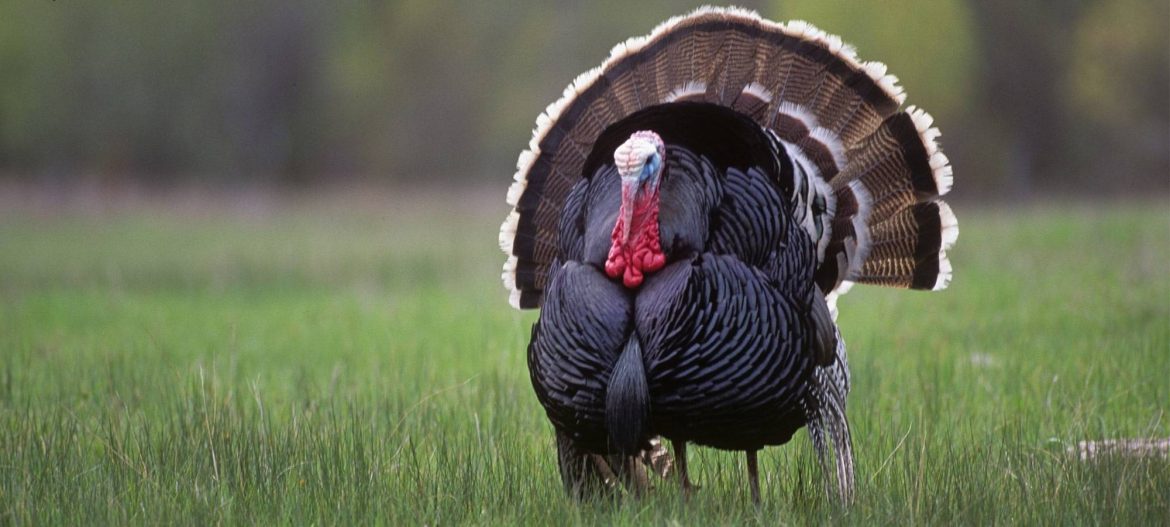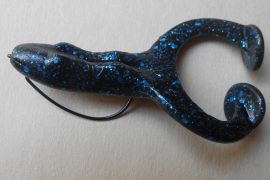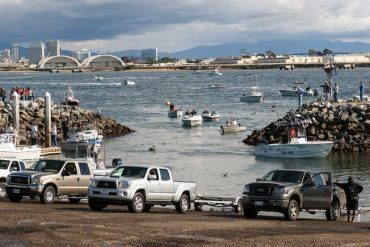
The modern age of seemingly unlimited turkey hunting opportunity creates a wonderful problem: We must decide how many trips to cram into one spring.
Do you concentrate on a few gobbler-rich areas or embark on a frenzied multi-state journey? Will it be wary Easterns in big timber, long-spurred Osceolas in a sunny pasture, hard-gobbling Rios across a mesquite flat or snow-white-tipped Merriam’s in the mountains or prairies — or all of the above? Turkey bums face tough decisions. Here’s some state-by-state information to help you this spring.
Scroll through, or use the links below to jump to your state:
Alabama
Subspecies: Eastern
Estimated population: 350,000 to 450,000 (based only on observational trends) Spring 2017 harvest: 29,893 (2016 harvest)
Overall outlook: “Observational brood survey data has shown a statewide reduction of poults per hen in recent years, but hens with broods remain good,” says Steve Barnett, district wildlife supervisor/wild turkey project leader for the Alabama Department of Conservation and Natural Resources. “The Avid Turkey Hunter Survey in 2017 showed an increase in numbers of jakes observed, which should reflect more two-year-old gobblers in the population.”
Potential Spring 2018 hotspots: Barnett said west-central and northeastern Alabama are the best areas. For wildlife-management areas, he suggested Choccolocco WMA, in Calhoun and Cleburne counties; and Oakmulgee WMA, in Bibb, Hale, Perry and Tuscaloosa counties.
Quick tip: Public-land hunting and wildlife management area information is available at: Outdoor Alabama
Season dates/bag limits: March 15 through April 30 (varies by zone). One gobbler per day, five per season. Turkey harvests must be recorded through Game Check.
Arizona
Subspecies: Merriam’s, Gould’s, Rio Grande
Estimated population: Merriam’s: 30,000; Gould’s: 1,200; Rio Grande: 200
Spring 2017 harvest:** Merriam’s: 942; Gould’s: 65; Rio Grande: 3
Overall outlook: “Overall, we have had several mild winters in a row, and the last three year classes should show strong representation,” says Rick Langley, Region 1 game specialist with the Arizona Game and Fish Department.
Potential Spring 2018 hotspots: Merriam’s hotspots include Unit 12A (North Kaibab), and units 1 and 27 (the White Mountains). Gould’s hotspots are any of the open units, if you can draw a permit. The lone Rio Grande hotspot is Unit 13B, the only one where permits are available.
Quick tip: “Turkey habitat in Arizona is almost exclusively U.S. Forest Service land, so access is easy,” says Langley. “But that means that everybody has equal access to the birds. Scouting can be very important, so you don’t waste valuable hunting time trying to locate birds. Azaccessmap.com is an online map program that shows land status, game waters, roads and many other valuable pieces of information.”
Season dates/bag limits: One turkey per year (can be killed in spring or fall). Youth-only: April 20 through 26 and May 11 through 24. Permits are limited in some units (draw only) and over the counter in some units (unlimited). Shotgun: Permits are limited in all units, and the draw deadline was October 2017. First hunt: April 27 through May 3 and May 11 through 24. Second hunt: May 4 through 24. Archery: available over the counter (unlimited in some units). May 11 through 24.
Arkansas
Subspecies: Eastern
Estimated population: 110,000 to 120,000
Spring 2017 harvest: 10,066
Overall outlook: Jason Honey, turkey program coordinator with the Arkansas Game and Fish Commission, says brood survey information indicates that 2017 gobbler carryover and 2016 poult production was similar to that of previous years. That probably indicates a 2018 harvest similar to that of the past few seasons. “One thing that can have a significant impact is weather,” he says. “Cold and rainy days usually mean less time for hunters to be in the woods. Heavily hunted areas are also usually harder to hunt with the added hunter pressure. This can cause gobblers to become less vocal.”
Potential Spring 2018 hotspots: Honey said the top public spots for 2017 turkey harvest were the Ozark National Forest, and Sylamore, Winona, Muddy Creek and Piney Creeks wildlife management areas. “I would also add Bear Cat Hollow to the list, as extensive habitat work has been completed,” he said.
Quick tip: “Scout a few different locations to have a backup plan if there are already hunters in the area,” Honey said. “Arkansas Game and Fish WMA maps are available at agfc.com, and U.S. Forest Service maps can be obtained by contacting the local ranger districts.
Season dates/bag limits: Zones 1, 2, 3, 4B, 5, 5B, 6, 7, 7A, 8, 9, 10 and 17: April 9 through 24. Zones 1A, 4, 4A, 5A and 9A: April 9 through 17. Special youth turkey hunt: zones 1, 1A, 2, 3, 4, 4A, 4B, 5, 5A, 5B, 6, 7, 7A, 8, 9, 9A, 10 and 17: April 7 and 8. No more than one legal turkey can be taken per day. The statewide bag limit is two legal turkeys; no jakes. Hunters 6 to 15 years old can harvest one jake as part of their two-bird limit (including the youth hunt). Hunters cannot exceed any zone harvest limits. Zones 1, 2, 3, 4B, 5, 5B, 6, 7, 7A, 8, 9, 10 and 17: two legal turkeys, no jakes. Zones 1A, 4, 4A, 5A and 9A: one legal turkey, no jakes. Hunters who kill a turkey in one of these zones must travel to another zone (including other one-bird-limit zones) to harvest a second turkey.

California
Subspecies: Mostly Rio Grandes, with some Merriam’s, Easterns and Eastern/Rio Grande hybrids
Estimated population: 250,000
Spring 2017 harvest: 15,770 (2016)
Overall outlook: “Good precipitation in the winter of 2016 and 2017 helped produce a good hatch,” says Scott Gardner, senior environmental scientist with the California Department of Fish and Game’s Upland/Small Game Program. “Turkey populations are up in California.”
Potential Spring 2018 hotspots: Gardner said the Coast Ranges, Central Valley and Sierra Nevada foothills regions might be potential spring hotspots.
Season dates/bag limits: General season: March 31 through May 6. Archery-only: May 7 through 20. Additional junior: March 24 and 25, May 7 through 20. Spring limit: three.
Colorado
Subspecies: Merriam’s, Rio Grandes
Estimated population: 35,000
Spring 2017 harvest: about 6,400 (plus or minus 400)
Overall outlook: Ed T. Gorman, small-game manager for Colorado Parks and Wildlife, says Colorado’s turkey population is stable or increasing.
Potential Spring 2018 hotspots: Typically, the best areas for Merriam’s are the southwestern and western portions of the state. These areas also have abundant public land.
Quick tip: “Each season is different,” says Gorman. “The best hunting does not always occur at the beginning of the season. Weather can play a huge role in where and at what elevation (if applicable) turkeys will be. Hunters that consider monthly trends in weather should have a good idea of whether birds will be concentrated at lower-elevation winter-type habitat or have begun to disperse into breeding habitat.”
Season dates/bag limits: April 14 through May 27. Some units have split seasons. Bag limit: two bearded turkeys in spring. One must be taken with a limited license; the other must be taken with an over-the-counter license.
Connecticut
Subspecies: Eastern
Estimated population: not available
Spring 2017 harvest: 1,584 (1,094 gobblers, 494 jakes, 6 bearded hens)
Overall outlook: “Although Connecticut has experienced some long-term declines in statewide populations, hunters should find fair numbers of jakes and two-year-old birds, indicated by fair productivity during the last two springs,” says Michael Gregonis, wildlife biologist II with the Connecticut Department of Energy and Environmental Protection.
Potential Spring 2018 hotspots: Gregonis said the northeastern part of Connecticut consistently posts the highest harvest rate.
Quick tip: “Since Connecticut is nearly 60 percent forested, forest openings are limited,” Gregonis said. “Therefore, hunters that seek out these open areas often are more successful than those that do not.”
Season dates/bag limits: April 25 through May 26. Bag limits: private land, three bearded birds; state land, two bearded birds.
Delaware
Subspecies: Eastern
Estimated population: 5,000 to 6,000
Spring 2017 harvest: 652
Overall outlook: Justyn R. Foth, waterfowl, turkey and upland game-bird biologist for the Delaware Division of Fish and Wildlife, said Delaware’s turkey population is stable, but productivity was low in 2017 because of bad weather.
Potential Spring 2018 hotspots: The top turkey zones in 2017 harvest were 4, 6, 7, 11 and 12.
Quick tip: “If (you’re) interested in hunting public lands, the draw for the 2018 season has already occurred, and all permits have been issued,” Foth said. “If interested in the 2019 season, please apply for our annual public lands turkey lottery by Jan. 4, 2019.”
Season dates/bag limits: April 14 through May 12. No Sunday hunting. Youth day: April 7. One bird per season.

Florida
Subspecies: Osceola, Eastern, intergrade
Estimated population: not available
Spring 2017 harvest: 22,307
Overall outlook: “Based on harvest metrics, the population seems to be on the increase,” says Roger Shields, wild turkey program coordinator for the Florida Fish and Wildlife Conservation Commission. “Given what seemed to be a couple of really good years of productivity back in 2015 and 2016, the 2.5- and 3.5-year age classes should be pretty strong this year.”
Potential Spring 2018 hotspots: “Not a hotspot, but the opposite, rather,” Shields says. “Given potential impacts from Hurricane Irma this past summer, even late as it occurred, there may still be some hits to this year’s productivity in the far southwest of Florida where this powerful Category 5 hurricane came ashore. Don’t be surprised if you see few jakes running around the woods this spring down there.”
Quick tip: Shields said hunters should check this website to find areas to hunt without a quota permit: myfwc.com/hunting/by-species/turkey/hunt-without-quota-permit/.
Season dates/bag limits: Youth hunt weekend: Feb. 24 and 25, south of State Road 70. March 10 and 11 north of State Road 70. Regular season: March 3 through April 8 south of State Road 70; March 17 through April 22 north of State Road 70. Bag limit: two per season. Daily bag limit: two per day on private land, one per day at wildlife management areas.
Georgia
Subspecies: Eastern
Estimated population: 300,000
Spring 2017 harvest: 25,702
Overall outlook: “With better reproduction in 2015 and 2016, much of the state will see a good 2018 season, with a good supply of two-year-old gobblers,” said Kevin Lowrey, wild turkey project coordinator for the Georgia Department of Natural Resources.
Potential Spring 2018 hotspots: Lowrey said the Piedmont, Blue Ridge and Upper Coastal Plain regions might see the best success rates this season.
Quick tip: “Patience kills turkeys,” Lowrey said. “With hunting allowed all day, stay with it and outlast the pressure on public lands, and you may go home a happy hunter.”
Season dates/bag limits: March 24 through May 15. Season limit: three gobblers.

Hawaii
Subspecies: Rio Grande
Estimated population: Not available. Turkeys inhabit Kauai, Maui, Molokai, Lanai, Oahu and the Big Island but can only be hunted in spring on the Big Island.
Spring 2017 harvest: not available
Overall outlook: “The overall outlook on the turkey numbers in the public hunting areas, in my opinion, is fair due to previous rain conditions the past two years during the hatch,” says guide and longtime NWTF volunteer Jon Sabati. “Hatch survival was low, resulting in a slump in the population. However, there are a few honey holes if you know where to go.”
Potential Spring 2017 hotspots: “Of course, private property or guided hunts are always great,” Sabati says. “I prefer to hunt on public land because I love the challenge, and if you know where to go, you can harvest a huge Rio (weight and beard). Mauna Kea is the go-to place. It is a huge volcano with a lot of ground to hunt. Elevations from 6,000 to 10,000 feet are where you can find turkeys.”
Quick tip: “Hunt during the week to avoid the weekend warriors,” Sabati said. “Leave your crow and coyote calls home. Turkeys may shock gobble to it, but it is not a natural sound here and may cause the turkeys to go the other way. It gets very cold in the morning. Bring a jacket. You may have to deal with foggy conditions, so bring your GPS.”
“You need a hunter safety certificate to buy a license,” he said. “It’s best to check with the Hawaii Hunter Education Program way ahead of a scheduled trip to see if your card is acceptable.
Season dates/bag limits: March 1 through April 15. Limit: three bearded turkeys.
Idaho
Subspecies: Primarily Merriam’s; Easterns; some pure-strain Rios in riparian areas by the Snake, Boise, Payette and Weiser rivers; a small population of Easterns near the Dworshak Reservoir; hybrids occur in many areas of the state.
Estimated population: not available
Spring 2017 harvest: about 3,500
Overall outlook: “Idaho is experiencing a very mild winter, and wild turkeys should have fared well,” said Jeff Knetter, biologist with the Idaho Department of Fish and Game. “I expect populations to be up from Spring 2017 levels.”
Potential Spring 2018 hotspots: “The Panhandle and Clearwater regions are consistently hotspots; lots of public land and turkeys available,” Knetter said. “The Southeast Region also provides excellent over-the-counter opportunity.”
Quick tip: “Turkeys will follow the snow line in spring, taking advantage of fresh green-up,” Mikal Moore, NWTF district biologist for the Pacific Northwest, said in 2017. “If you are hunting an elevation gradient, follow the snow melt, and look for turkey sign.”
Season dates/bag limits: Youth seasons: April 8 through 14. Regular seasons: April 15 through May 25 (varies by unit). Limit: two turkeys, both of which can be taken the same day with a general and extra tag available to hunters.
Illinois
Subspecies: Eastern
Estimated population: not available
Spring 2017 harvest: 15,720
Overall outlook: “While spring turkey hunters can always anticipate quality turkey hunting in Illinois, they are expected to harvest fewer birds statewide than the previous two spring seasons,” says Luke Garver, wild turkey project manager with the Illinois Department of Natural Resources. “Production estimates were the lowest on record this summer; likely because of torrential rain experienced across much of the state in early spring. The timing of these rains could have wiped out many first nest attempts or possibly even some early-hatched poults. As a result, there will be fewer jakes on the landscape and, as a result of poor production last year, fewer two-year-old birds, as well.”
Potential Spring 2018 hotspots: Garver said perennial spring hotspots include more heavily forested counties in southern Illinois, the driftless area in the northwestern part of the state, and the Mississippi and Illinois river corridors in western Illinois. The top five 2017 harvest counties were Jo Daviess, Jefferson, Pike, Adams and Fulton.
Quick tip: “If hunters are interested in Illinois’ top-tier public sites for turkey hunting, they should be sure to set their calendars for Dec. 1, which is the deadline for the first lottery,” Garver said. “Most of the best sites allocate 100 percent of their permit quota in that lottery. Turkey hunters looking for more access to places to hunt should check out IDNR’s Illinois Recreational Access Program. Through this program, hunters can apply for access to private land to hunt. In exchange, landowners receive help with managing wildlife habitat on their property. More information can be found at: Illinois Recreational Access Program.
Season dates/bag limits: Youth season: March 31 through April 1, and April 7 through 8. Regular season, North Zone: five segments running April 16 through May 17. Regular season, South Zone: five segments running April 9 through May 10. Bag limit: one bearded turkey per valid permit; maximum of three permits per hunter.
Indiana
Subspecies: Eastern
Estimated population: 120,000 to 130,000
Spring 2017 harvest: 13,069
Overall outlook: Steven E. Backs, wildlife research biologist and wild turkey statewide project leader for the Indiana Division of Fish and Wildlife, says jakes comprised about 13 percent of the Spring 2017 harvest, which indicates that a decade of generally subpar production will result in fewer two-year-olds for Spring 2018. In turn, he said, that will likely result in lower gobbling activity, increased hunter frustration and probably a decrease in harvest from 2017.
Potential Spring 2018 hotspots: “The harvest in the northern third of the state appears to holding up much better than the historically strong southeastern and south-central regions of the state,” Backs says. “There has been some localized rebound in turkey populations in some of west-central and southwestern regions from a few years ago, when severe flooding during the nesting and brood-rearing periods severely impacted production along river drainages and lowlands.”
Quick tip: “As is always the case, pre-season preparations can pay big dividends early in the season, while patience, perseverance and experience rule once the season gets underway,” Backs said.
Season dates/bag limits: April 25 through May 13. Youth weekend: April 21 and 22. Spring limit: one bearded or male turkey.

Iowa
Subspecies: Eastern
Estimated population: 110,000 to 150,000
Spring 2017 harvest: 11,779
Overall outlook: “The statewide population will remain stable,” says Jim Coffey forest wildlife research biologist for the Iowa Department of Natural Resources. He added that biologists have seen population increases in the northwestern and north-central regions, but limited habitat in those areas can make hunting a challenge.
Potential Spring 2018 hotspots: “Northeastern Iowa continues to have good turkey numbers and provides a lot of turkey habitat,” Coffey said.
Quick tip: “Always check the Iowa DNR Atlas for public lands open to hunting,” Coffey said. “Permission is needed on private lands.”
Season dates/bag limits: Resident youth season: April 7 through 15. First season, April 16 through 19; second season, April 20 through 24; third season, April 25 through May 1; fourth season, May 2 through 20; bow season, April 16 through May 20. Limit: one bearded or male wild turkey per permit. Residents can have up to two spring permits. Nonresidents are allowed one by lottery.
Subspecies: Eastern, Rio Grande, hybrid
Estimated population: not available
Spring 2017 harvest: 30,441
Overall outlook: “Production has declined across much of the state in recent years, and numbers of adult birds have declined from all-time highs of 10 to 15 years ago,” says Kent Fricke, small-game coordinator for the Kansas Department of Wildlife, Parks and Tourism. “However, those declines may be stabilizing. Overall, populations remain relatively strong. Hunters should expect to find fair to good numbers of Easterns in the eastern portion of the state and fair to good numbers of Rios in western Kansas.”
Potential Spring 2018 hotspots: Fricke said the northern and south-central regions should again provide quality hunting opportunities.
Quick tip: “With about 600,000 acres of publicly accessible hunting ground in public lands and Walk-In Hunting Access properties, as well as an almost two-month season, hunters have a variety of options across Kansas to have a successful and enjoyable hunt,” Fricke says.
Season dates/bag limits: Youth/disabled, April 1 through 17; archery, April 9 through 17; regular firearms/archery, April 18 through May 31. Spring limit: two male or bearded birds per day, season (spring turkey permit and second turkey game tag, valid for units 1, 2, 3, 5 and 6).
Kentucky
Subspecies: Eastern
Estimated population: 330,000 to 440,000
Spring 2017 harvest: 33,061
Overall outlook: “Last spring’s excellent harvest (essentially tied with 2012’s 33,067 birds harvested) was no doubt a product of a good hatch and brood production in 2015 relative to recent years,” says Zak Danks, turkey program coordinator for the Kentucky Department of Fish and Wildlife Resources. “Unfortunately, spring and summer of 2016 saw our second lowest production year of the past decade. Thus, I wouldn’t expect to top Spring 2017. But keep in mind, our statewide harvest has remained strong for several years. There should be plenty of gobblers for Kentucky hunters this spring.”
Potential Spring 2018 hotspots: Danks said the entire state offers good opportunities, from the mixed crop/pasture country in the western two-thirds of the state to mountain birds in the Cumberland Plateau of eastern Kentucky.
Quick tip: “Utilize aerial imagery available on Google Earth (and others) to find spots to hunt to make scouting more productive,” Danks says.
Season dates/bag limits: Youth: April 7 and 8. General season: April 14 through May 6. Limit: two bearded birds; one per day.
Louisiana
Subspecies: Eastern
Estimated population: 50,000 to 60,000
Spring 2017 harvest estimate: 5,700
Overall outlook: “Like many other states, we are experiencing long-term declines in production and harvest, which are indicative of declining populations,” says Cody Cedotal, small-game and wild turkey program manager with the Louisiana Department of Wildlife and Fisheries. “In more recent years, wild turkey production has been suppressed, though harvests have remained somewhat stable. We are hopeful for favorable conditions this year and an increase in production.”
Potential Spring 2018 hotspots: Counties in western Louisiana have some of the strongest turkey populations, Cedotal said. Kisatchie National Forest and Fort Polk and Peason Ridge wildlife management areas provide quality turkey habitat and are popular destinations.
Quick tip: “Get acquainted with any new areas you may be traveling to,” Cedotal said. “Acquire maps and any on-the-ground knowledge you can well in advance of your travel.”
Season dates and bag limits: One gobbler per day, two per season. Youth season: March 30 through April 1. Area A: April 7 through May 6; Area B: April 7 through 29; Area C: April 7 through 22.
Subspecies: Eastern
Estimated population: 60,000
Spring 2017 harvest: 5,600
Overall outlook: Kelsey Sullivan, wildlife biologist with the Game Bird Program for the Maine Department of Inland Fisheries and Wildlife, says Maine’s turkey population is stable, and that hunters should see lots of two-year-olds in 2018, thanks to a productive Spring 2016.
Potential Spring 2018 hotspots: Sullivan mentioned Waldo, Penobscot, and Cumberland counties. Northern Maine, she added, has very low turkey numbers, and birds are concentrated in small areas.
Quick tip: “Landowner access is generally favorable,”…





